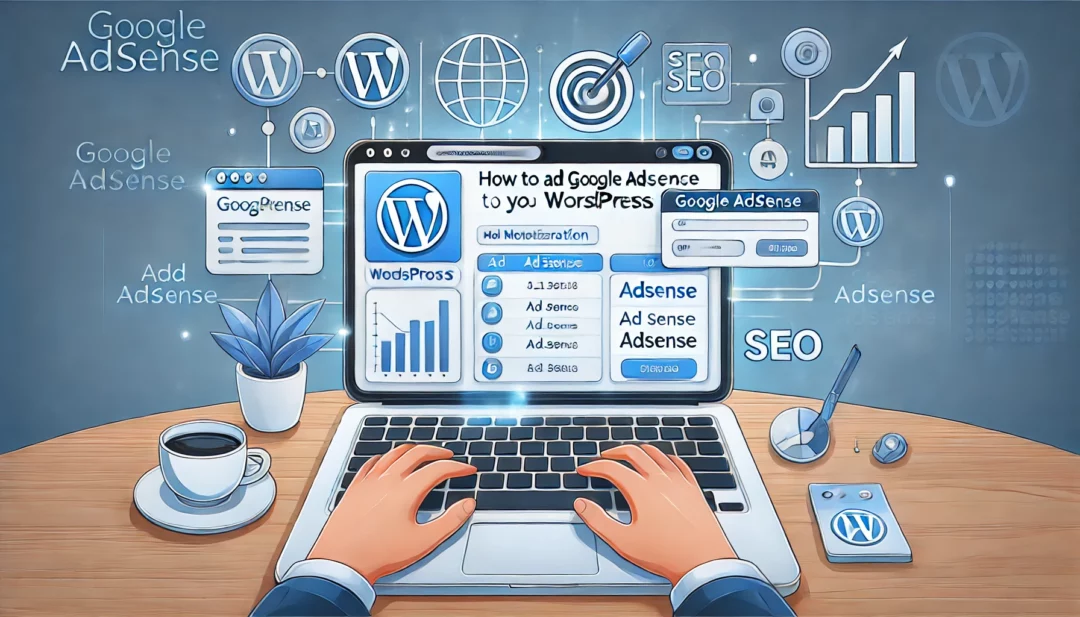
Monetizing your WordPress site with Google AdSense is a smart way to generate passive income. Whether you’re running a blog, portfolio, or business site, adding AdSense can help you earn by displaying relevant ads to your audience. The good news? It’s easier than you think to get started.
You’ll begin by signing up for a Google AdSense account and getting it approved. Next, generate your ad code from the AdSense dashboard. Then, integrate the code into your WordPress site using widgets, plugins, or theme editors, depending on your preference. Finally, customize your ad placements to ensure they blend seamlessly with your site’s design while maximizing visibility.
Understanding Google Adsense
Google AdSense is a platform that enables you to monetize your WordPress site by displaying targeted advertisements. It’s widely used due to its seamless integration, ease of use, and revenue-generating potential.
What Is Google Adsense?
Google AdSense is an advertising program managed by Google that connects publishers with advertisers. It displays ads relevant to your content using algorithms and matches them based on user interests. Ad types include text ads, display ads, and video ads.
Once integrated, Google tracks user interaction with the ads and calculates revenue through models like CPC (Cost Per Click) or CPM (Cost Per Thousand Impressions). Earnings depend on the volume and behavior of site traffic.
- Passive Income Generation
AdSense requires minimal management after setup. Ads run automatically, earning revenue as users interact with displayed content.
- Customizability
AdSense allows you to customize ad placements and styles to match your site’s design without affecting its user experience.
- High Compatibility
The platform integrates seamlessly with WordPress via plugins like Ad Inserter or the Site Kit by Google, simplifying setup and management.
- Ad Relevance
Ads are tailored to audience preferences, ensuring engagement and better revenue potential.
- Secure Platform
Google handles payment processing and ensures that only verified ads appear on your site, protecting its credibility.
Preparing Your WordPress Site For Adsense
To integrate AdSense with your WordPress site, you must ensure your site meets Google’s guidelines. This involves technical readiness, compliance with policies, and optimizing for user experience.
Essential Requirements Before Adding AdSense
- High-Quality Content
Publish original, valuable, and relevant content. Google prioritizes sites with well-organized posts and proper grammar. Avoid plagiarized, thin, or auto-generated content.
- Domain Age and Ownership
Use a domain registered for at least 6 months, particularly in regions like India and China. Ensure you’re the domain’s verified owner in your hosting and WordPress setup.
- AdSense Compliance
Familiarize yourself with Google AdSense Program Policies. Prohibited content includes adult themes, pirated material, and harmful practices.
- Responsive Website Design
Optimize your theme for mobile-friendliness, as over 50% of web traffic comes from mobile devices. Google’s free Mobile-Friendly Test can validate this.
- Functional Pages
Include essential pages like About Us, Contact Us, Privacy Policy, and Terms of Service. These pages establish credibility and are crucial for approval.
- Moderate Traffic
Grow organic traffic through SEO practices and original content. Though AdSense doesn’t specify traffic thresholds, a steady flow of visitors improves your application’s chances.
- Sign Up for an Account
Navigate to Google AdSense and create an account using your Google ID. Provide accurate personal and website details.
- Connect Your Website
Add your site in the AdSense dashboard. Copy the provided ad code snippet and paste it into the <head> section of your WordPress theme via a child theme or header plugin.
- Enable AdSense Auto Ads
Auto ads simplify setup by analyzing your content and placing optimized ads automatically. Activate this feature in the dashboard.
- Verify Site Ownership
AdSense requires site verification before approving your application. After installing the ad code, complete verification in your account.
- Wait for Review
Google’s manual review process typically takes 2-4 business days. Check your email for updates or reapply if initially disapproved.
- Optimize Content During Review
Continue posting quality content. Avoid making significant design changes or removing user-friendly pages to pass the review seamlessly.
How To Add Adsense To WordPress
To monetize your WordPress site with Google AdSense, integrate the ad code efficiently through plugins or manual methods. Proper setup ensures better ad visibility and seamless performance. Explore these approaches to add AdSense to your WordPress site.
Using The Official Adsense Plugin
Google provides an official AdSense plugin, Google Site Kit, to simplify integration with WordPress. Follow these steps to set it up:
- Install and Activate Site Kit: Go to the WordPress dashboard, navigate to “Plugins,” and search for “Google Site Kit.” Install and activate the plugin.
- Connect Your Google Account: Open the Site Kit setup wizard and log in with your Google account associated with AdSense.
- Verify Your Site Ownership: Connect your WordPress site to AdSense within the plugin to verify ownership automatically.
- Enable Auto Ads: Site Kit allows you to manage Auto Ads. Configure ad settings and placement directly through the plugin interface.
This method integrates AdSense without needing technical skills, making it ideal for beginners.
Adding Adsense Code Manually
Manually adding AdSense code gives more control over ad placement. Use these steps to add the code:
- Get Your Ad Code: Sign in to your AdSense account, go to “Ads,” and create an ad unit. Copy the generated ad code.
- Edit Theme Files: In the WordPress dashboard, navigate to “Appearance,” then “Theme File Editor.” Locate header.php or widget areas for desired placement.
- Insert Code: Paste the AdSense code into the
<head>section for global ads or a specific widget area for local ads. Save changes. - Check Ad Rendering: Visit your site to confirm ads display correctly. Clear cache if ads don’t appear immediately.
Manual integration works best if you’re familiar with CSS/HTML basics and want tailored ad placements.
Using A Third-Party Plugin For Adsense
Third-party plugins provide additional features and flexibility for managing AdSense. Popular options include Ad Inserter and Advanced Ads. Follow these steps to set up:
- Install the Plugin: Search the WordPress plugin directory for your preferred AdSense management tool. Install and activate it.
- Configure Ad Settings: Open the plugin’s settings panel. Enter your AdSense code and set the placement rules.
- Customize Ad Layouts: Choose the ad type, alignment, and visibility preferences. Many plugins support shortcode use for more specific placements.
- Preview Ads: Test different locations to evaluate performance. Adjust configurations based on results.
Third-party plugins suit those managing multiple ad networks or requiring advanced features like A/B testing.
Tips To Optimize Adsense Performance On WordPress
Effectively optimizing AdSense on your WordPress site increases ad revenue and enhances the user experience. Focus on strategic placements, user-centric designs, and ad relevancy to maintain audience engagement.
Choosing The Best Ad Placement
Strategically placing ads improves visibility and user interaction. Follow these steps to select optimal placements:
- Above The Fold: Position ads within the top screen view to capture attention. For instance, integrate a leaderboard ad under the header.
- Within Content: Embed ads in between paragraphs or after the first 300 words. These placements feel natural and ensure higher engagement.
- Sidebar Widgets: Place responsive banner ads in the sidebar using WordPress widgets, ensuring visibility without being intrusive.
- Avoid Overcrowding: Limit ads per page to three main placements (e.g., header, sidebar, within content) to avoid overwhelming users. Excessive ads may lower visit duration and revenue.
- Optimize Load Times: Compress images, use caching plugins, and enable lazy loading. Faster websites keep users engaged while displaying ads.
- Use Responsive Ads: Display ads that adjust to screen sizes. Responsive design prevents distorted layouts on mobile devices.
- Ad Styling: Match ads to your site’s design by customizing font and color. Consistent styling avoids a cluttered appearance.
- Limit Intrusive Formats: Avoid pop-ups or autoplay video ads, as they disrupt navigation and increase bounce rates.
- Test Ad Performance: Use A/B testing, available in tools like Ad Inserter, to determine which placements yield better click-through rates (CTR).
Common Troubleshooting Issues
Adding AdSense to your WordPress site may occasionally come with challenges. Understanding and addressing common issues ensures ads display correctly and comply with policies.
Why Adsense May Not Appear On Your Site
AdSense ads may not appear due to issues with setup, approval, or technical errors.
- Pending Approval: Ads won’t show if Google’s approval process isn’t complete. Confirm your AdSense account’s approval status in the AdSense dashboard. Maintain policy-compliant content while waiting.
- Incorrect Ad Code Placement: Ads fail to display if the code isn’t inserted correctly. Double-check that you’ve copied the entire ad code and placed it in the appropriate sections, such as theme files or widgets.
- Ad Blocking Plugins: Extensions or plugins like AdBlock can prevent ads from rendering. Test your site with such tools disabled.
- Policy Compliance Issues: If your site violates AdSense policies, ads might not activate. Verify that your site adheres to guidelines on content quality, prohibited content, and essential page requirements.
- Script Conflicts: Third-party scripts may interfere with ad scripts. Temporarily deactivate plugins and themes to pinpoint the conflict.
Resolving Adsense Policy Violations
Policy violations can restrict ad serving, making adherence to AdSense requirements critical.
- Review the Policy Center: Identify violations in the AdSense Policy Center. Google often specifies the issue and provides guidance for resolution.
- Correct Content Issues: Update or remove non-compliant content, including adult material, copyrighted content, or excessive keywords. Ensure your content provides value and aligns with AdSense standards.
- Add Required Pages: Missing pages like Privacy Policy, Terms of Service, or About Us can lead to violations. Create these pages to enhance site credibility.
- Secure the Website: An unsecured site can raise security concerns. Implement an SSL certificate and ensure HTTPS is active across all pages.
- Reapply Post-Changes: Once violations are resolved, request a review through the Policy Center. Ensure all changes are completed before submission.
Addressing these problems promptly minimizes disruptions while maintaining consistent ad revenue.
Conclusion
Adding Google AdSense to your WordPress site is a powerful way to generate passive income while maintaining a user-friendly experience. By following the right steps and focusing on quality content, strategic ad placements, and compliance with AdSense policies, you can maximize your site’s earning potential.
With tools like the Google Site Kit plugin or manual integration options, you have the flexibility to choose what works best for your technical expertise. Remember to monitor performance, optimize placements, and stay updated with AdSense guidelines to ensure long-term success.
Frequently Asked Questions
1. What is Google AdSense?
Google AdSense is a platform that connects website publishers with advertisers, allowing advertisers to display targeted ads on your site. Publishers earn revenue when users interact with these ads, using models like CPC (Cost Per Click) and CPM (Cost Per Thousand Impressions).
2. How does Google AdSense generate revenue?
AdSense generates revenue by displaying ads relevant to your site’s content. You earn money when users click on ads (CPC) or when ads get a certain number of views (CPM).
3. Is Google AdSense compatible with WordPress?
Yes, Google AdSense has high compatibility with WordPress. You can easily integrate it using methods like the Google Site Kit plugin, manual ad code placement, or third-party plugins.
4. What are the basic requirements to get approved for AdSense?
To qualify for AdSense, you need high-quality content, domain ownership, a responsive design, compliance with AdSense policies, and essential pages like About Us and Privacy Policy.
5. How can I add AdSense to my WordPress site?
You can add AdSense to a WordPress site using the Google Site Kit plugin, manual code integration into theme files, or plugins like Ad Inserter for advanced options.
6. What types of ads does AdSense display?
AdSense displays various ad formats, including text ads, display ads, video ads, and responsive ads. You can choose the type that best suits your site’s design.
7. Why aren’t ads appearing on my WordPress site?
Ads may not appear due to pending approval, incorrect code placement, ad-blocking plugins, policy violations, or script conflicts. Ensure compliance with AdSense policies and verify proper integration.
8. What is the best way to optimize AdSense ad performance?
Maximize ad performance by placing ads strategically above the fold, within content, or in sidebars. Use responsive ads, customize ad styling, limit intrusive formats, and A/B test placements.
9. Can I manage Google AdSense with zero technical skills?
Yes, the Google Site Kit plugin simplifies setup and management by providing easy integration, automatic ad placement, and insights without needing technical expertise.
10. Is it possible to customize where ads are displayed?
Absolutely. AdSense allows you to customize ad placements to fit your site design. Tools like Ad Inserter or Advanced Ads provide flexibility and advanced options for customization.
11. How long does it take to get approved by Google AdSense?
Approval can take a few days to several weeks. Ensure your site is policy-compliant, has quality content, and includes required pages to improve your chances.
12. How do I resolve AdSense policy violations?
Review the AdSense Policy Center to identify violations. Fix content issues, add required pages, improve security, and reapply after making necessary corrections.
13. Do I have to manage ads after integrating AdSense?
Once set up, AdSense requires minimal management. Auto Ads handle ad placements, while monitoring and optimizing performance can further maximize revenue.
14. What are Auto Ads in Google AdSense?
Auto Ads are an AdSense feature that automatically places ads on your site for optimal performance. It reduces manual effort and ensures user-friendly ad setups.
15. Can I use third-party plugins to manage AdSense?
Yes, plugins like Ad Inserter and Advanced Ads offer advanced options, including A/B testing, custom placements, and enhanced performance tracking.



